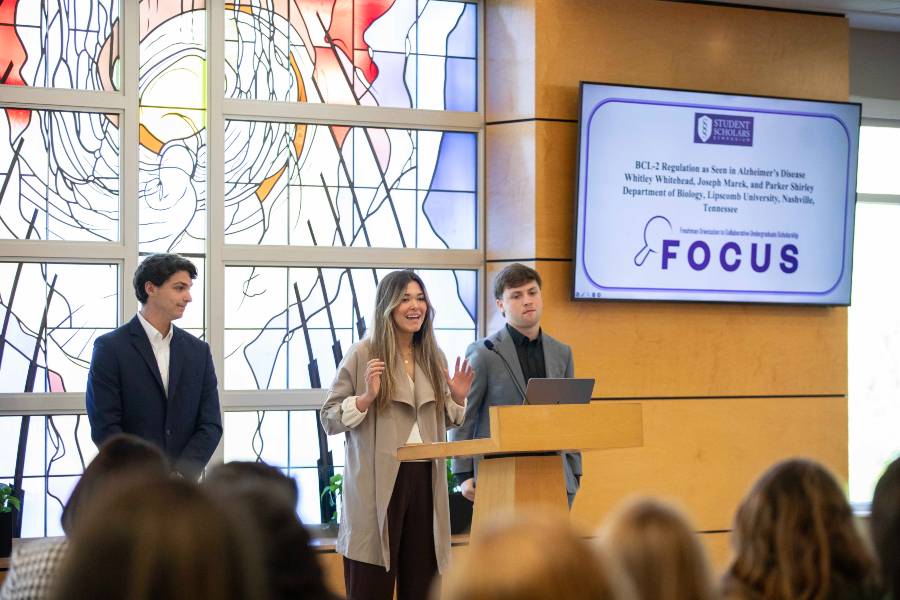2025 Student Scholars Symposium held on April 16-17
New focus on freshman and creative arts highlights 14th annual celebration of student scholarship.
Janel Shoun-Smith | 615-966-7078 |
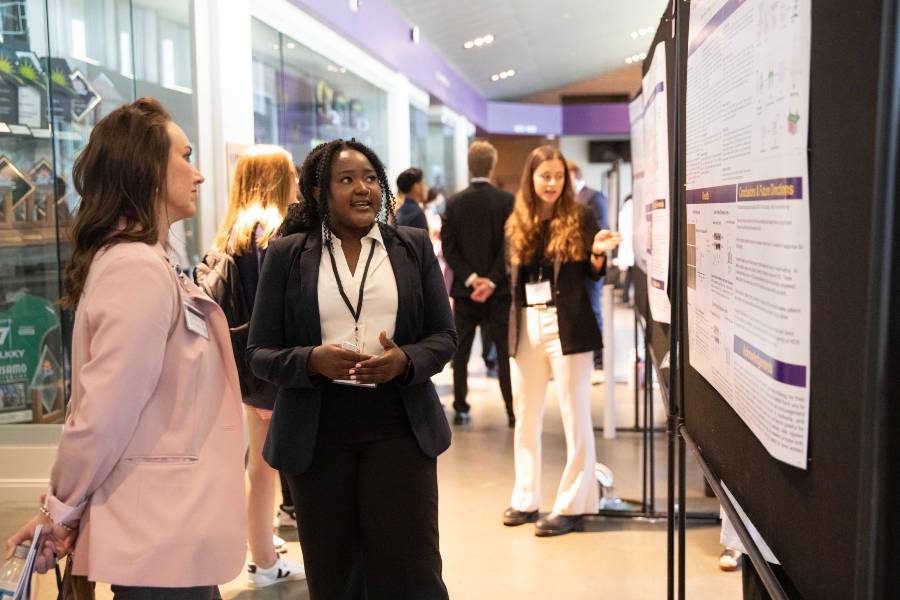
Throughout the symposium, 362 students presented their work ranging from theatrical scenic design to steps toward a cure for cancer.
Whether it is an automatic latte art machine or a presentation on the creation of cat costumes, new insight into the causes of cancer or new ways to bring clean water to the disadvantaged world, Lipscomb’s annual Student Scholars Symposium is a showcase of anything and everything that students are discovering.
The 2025 symposium in April was a milestone event with new features that focused on research by freshmen and a format intended to highlight the creative arts. The annual celebration of the creative and scholarly works of Lipscomb students was expanded to two days, with the first day including a FOCUS session with all freshman presenters and the rest of the day devoted to creative arts such as poetry, theatre, music and creative writing.
Eleven freshmen presented on topics ranging from the evolution of communication to the cellular processes involved in cancer. Next 42 students presented creative works throughout the day in Collins Alumni Auditorium.
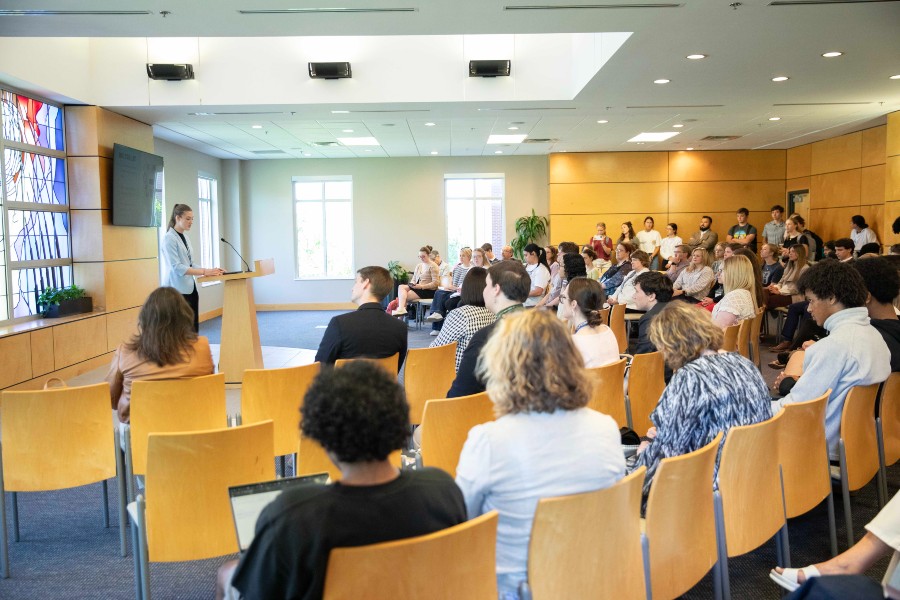
Eleven freshmen presented in the FOCUS session on topics ranging from the evolution of communication to the cellular processes involved in cancer.
One freshman or team was selected by faculty from each Lipscomb Experience course, a foundational course required for all freshmen to introduce them to the critical thinking and communications skills needed to succeed throughout the rest of their college career.
The inaugural freshman FOCUS presentations were:
- From Oral Traditions to Digital Screens: The Evolution of Folklore in the Modern Age by Echo Padgett;
- In a relationship: Can AI take the place of a human relationship? by Hannah Smith;
- The Impact of p53 in Cervical Cancer by Isabella English and Elijah Chism;
- Ramifications of HER2 Amplification in Breast Cancer by Emerald Cole and Zoe Grace Brigance:
- Myocardial PI3K-AKT Pathway and Cardiovascular Disease Etiology by Bryson Lovorn and Brennan Kaplan
- BCL-2 Regulation in Alzheimer’s Disease by Whitley Whitehead, Joseph Marek and Parker Shirley
On the second day, the symposium included a keynote luncheon, 22 sessions of oral presentations, two poster sessions displaying 110 posters and two special panels, one on the design aspects of the Lipscomb production of Antigone in Munich and one to highlight the artwork of students in Lipscomb’s LIFE program, where traditional students enroll in courses held onsite at the Debra K. Johnson Rehabilitation Center (DJRC) and study alongside residents of DJRC.
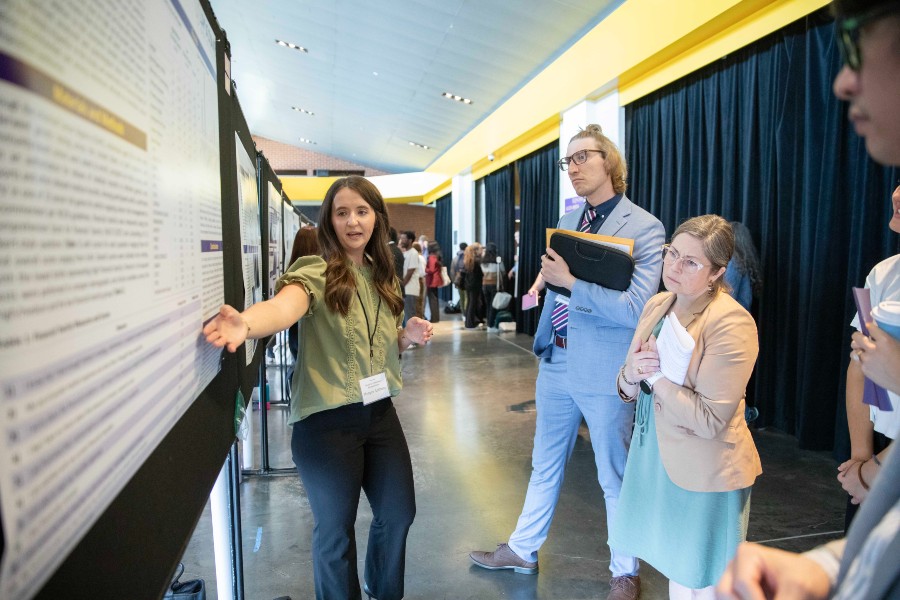
On the second day of the symposium, two poster sessions displayed 110 posters from students in eight of Lipscomb's colleges.
Both undergraduate and graduate students participate in oral presentations and poster sessions, with 362 students from eight Lipscomb colleges presenting throughout the day. An outstanding presenter from each presentation session and from each of 22 poster presentation groups is selected to be honored at an event-ending awards reception.
Student’s presentations and posters this year span a wide range of topics and disciplines including:
- A theater student presentation on the visualization and creation of the costumes for Lipscomb’s fall production of the musical Cats;
- Chemistry students’ presentation on a methods to detect toxic chemicals in the covers of Victorian-era books and a poster on detecting toxins in costume jewelry;
- An environmental biology student’s poster comparing vertical hydroponic farming to soil farming;
- Engineering students’ posters showing recommendations for easing traffic congestion at Nashville’s Opry Mills Mall and to regulate temperatures in the Gaylord Opryland Hotel atrium;
- Psychology students’ poster on how the Prosperity Gospel interacts with life stress and religious doubt;
- Engineering students’ poster describing how one group created an automatic machine to make art with cocoa powder on a latte and another group designed a water distribution system for a community in Guatemala;
- Communications students’ posters on various facets of the use of A.I. today and tomorrow; and
- A wide range of presentations and posters regarding biological research into the proteins, cells and bacteria involved in various types of cancer, Crohn’s disease, parasitic worms, obesity and gastrointestinal diseases impacting premature infants, among others.
This year’s keynote speaker, Dr. Nicole Molumby, spoke on the theme, “Think Big! Creativity and Human Centered Research,” making the case that co-creation, or collaborative research and creation, has greater benefits for both the researchers and society.
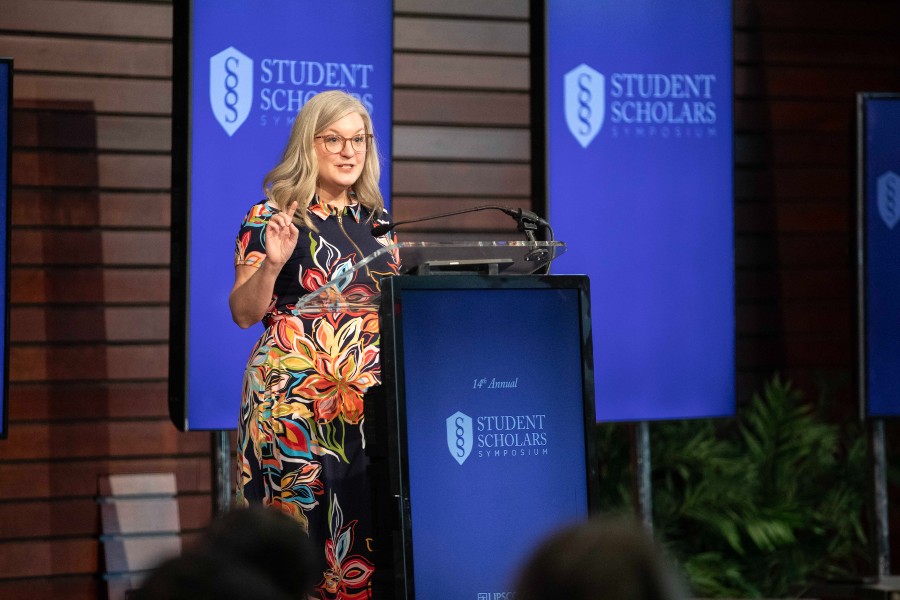
This year’s keynote speaker, Dr. Nicole Molumby, spoke on the theme, “Think Big! Creativity and Human Centered Research.”
Molumby is the graduate program director for interdisciplinary studies, as well as a professor of flute, at Boise State University, where she collaborates with the Division of Research and Economic Development to equip graduate students and faculty with the skills to co-design human-centered research. The goal of these cross-disciplinary collaborations is to enable researchers to apply their skills to tackle grand challenges.
She encouraged the gathered students to see failure as a necessary part of the co-creation process, to see curiosity as courage, to strive to learn and adapt together and to recognize the “power of the pivot” when a new out-of-the-box opportunity may arise.
“This is the future of research, not from the isolated individual in the lab, but through collaboration and communities committed to making an impact,” said Molumby, emphasizing that research done with, not for, communities is a force for real change and social and economic impact. “And you, as emerging researchers, are already part of that future.
“As you step into your own journey as a researcher, creator or problem solver, I want to leave you with this,” she concluded. “The most meaningful research doesn't start with having all the answers, it starts with asking better questions. It begins with curiosity and it grows through creativity, collaboration and the willingness to try, fail and try again.”

2025 Student Scholars Symposium Outstanding Presenters
Undergraduate Oral Presentations
Investigating the Potential Ability of the TLR4-NF-κB Axis to Reduce Aryl Hydrocarbon Receptor Expression in Intestinal Epithelial Cells
Gabriella Longoria, Biology
The “No Best World” Argument: A Strong Or Weak Objection to the Possibility of Perfect Goodness
Hudson Tucker, History, Politics and Philosophy
Little Women Dramaturgical Research Packet
Elanah Bruce, Theatre
Elucidating the Mechanism of Neprilysin-Regulated Triple Negative Breast Cancer Invasion
Kai Lam, Ellie Griner, Biology
The Treatment of Polycystic Ovary Syndrome (PCOS) Using Synthetic Hormone Therapy Versus Holistic Approaches: An integrative review
Sarah Mullin, Olivia Matis, Olivia Fair, Emma Joy Dolan, Nursing
Elucidating the Effects of HD5 on ACTC1 Expression in Crohn’s Disease
Carolyn Tran, Sohir Abdelnour, Joyce Lawson, Ellis Puscas, Biology
What are the global differences in air quality due to the Covid-19 pandemic?
Jude Spencer, Ian McGee, Brandon Solis-Martinez, Biology
Indole improves outcomes of Cronobacter sakazakii infection in C. elegans through ahr-1
Cayden Durrough, Biology
Xibalbay, Guatemala Water Distribution System Design
Nolen Ritzel, Lauren Baker, Robert Trey Owen, Jessamine Reckard, Joelle Noble, Sara Berry-Brown, Civil Engineering
Using Feynman’s Technique to Evaluate Non-elementary Integrals Used in Physics
Dominick Dingus, Christopher Wengert, Madouna Barsoum, Physics
Long term financial analysis for Opry Mills Hotel and Resort
Eli Lockert, Civil Engineering
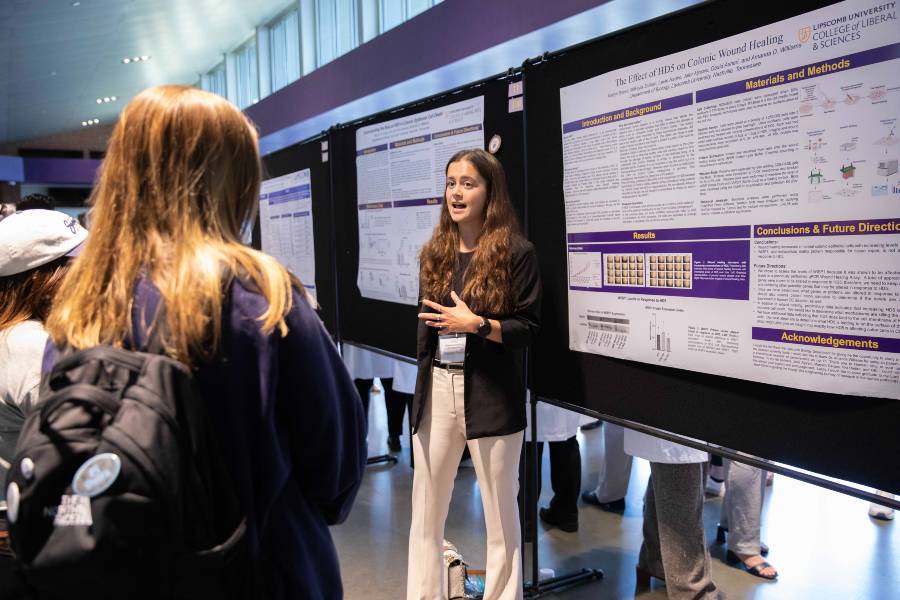
Both graduate and undergraduate students made 207 presentations on research and scholarship in a wide variety of fields of study.
6PPD-Quinone in Middle Tennessee Waters: Assessing Ecological Impact
Andrew Davis Todd, Raphael Marquise Chandler, Kerolos Gerges Basalos, Denise Lori Loewinger, Pharmaceutical Science
The Loss of Meg3 Causes Abnormal Alveolar Epithelial Progenitor Cell Differentiation
Arlo Colvard, Gianluca DiGiovanni, Isabella Gaona, Sergey S. Gutor, Ujjal Singha, Taylor P. Sherrill, David S. Nichols, Yunli Zhou, Jonathan A. Kropski, Ward Research Fellowship
Exploring the Effects of Indoor Plants on Executive Function
Jose Romero, Psychology
Prosperity Gospel Orientation Interacts with Life Stress to Impact Religious Doubt and Psychological Well-being
Ellie Stork, Grace Henry, Haley Rose Wills, Joanna Jernigan, Peyton Smith, Josephine Magar, Rachel Russell, Psychology
Effect of Sugar Alternatives in Dairy Free Coconut Milk Based Ice Cream on Sensory Characteristics and Acceptability
Maggie Hegg, Remi Petty, Jay Edwards, Nutrition
3D Modeling of Brain Removal with Cranial Nerve Preservation
Lauren Blank, Sophi Cox, Jill Kirby, Mike Meredith, Charles Long, Biology
Evaluating the Impact of Precast vs. Cast-in-Place Concrete: A Life Cycle Assessment of a Parking Garage in Nashville
Robert Owen, Civil Engineering
AI Photography-Based Gradation Feasibility Study for Streams and Rivers in Davidson County, TN
Nolen Ritzel, Lauren Baker, and Jordan Wilson, Civil Engineering
A Teacher, Medical Advisor, and a Comedian Walk into a Bar: Table for one, Everything AI can do
Lorelai M. Kline, Communication
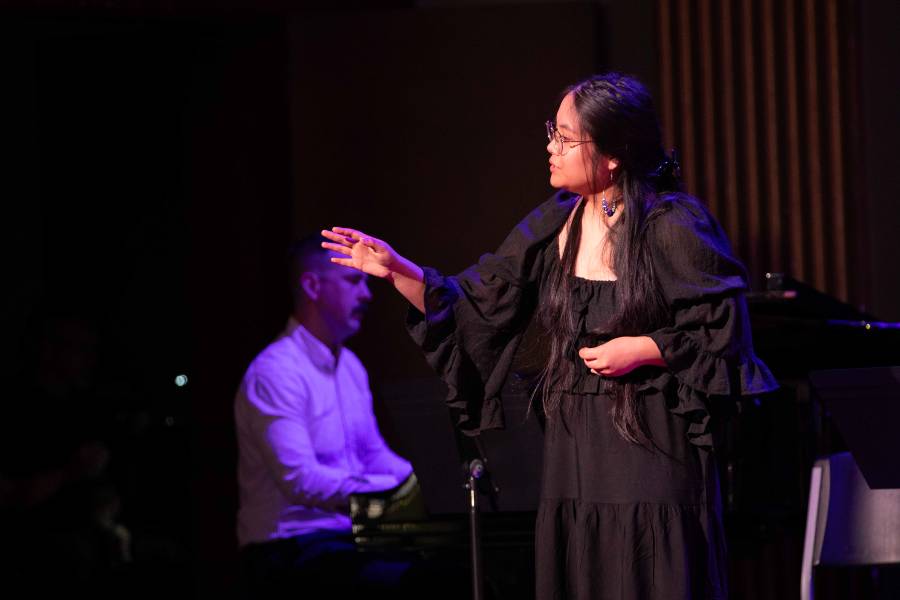
Forty-two students presented creative works, such as poetry, music, theatrical scenes and creative writing, throughout the first day in Collins Alumni Auditorium.
Unveiling Hidden Hazards: A Complementary Approach to Affordable Nondestructive Heavy Metal Detection
Mario Faragalla, Gulsin Barwari, Mackenzie Brinkoeter, Eimy Lozano-Fuentes, Isabelle Riera, Chemistry and Biochemistry
The Metabolic Effects of Carbon-Plated Shoes on D1 Runners
Bingham Hudson, Cole Kimmel, James Schmidt, Adam Macleod, Kinesiology
Syllabus Tone and Student Self-Efficacy
Natalia Calderon-Hernandez, Alan Avila, Psychology
Investigating the Effects of Body Composition Assessment on Dietary Intake in Division I Football Players
Cameron Nill, Nicole DiCicco, Nutrition
Driving Social Revolutions in 20th Century Latin America
Oliver Orellana, History, Politics and Philosophy
English Loanwords and their Sociolinguistic Impact on the Japanese Language
Zoe Macgill, English and Modern Languages
Painting the Past: Trauma and Identity in The Best We Could Do
Ellie Heslon, English and Modern Languages
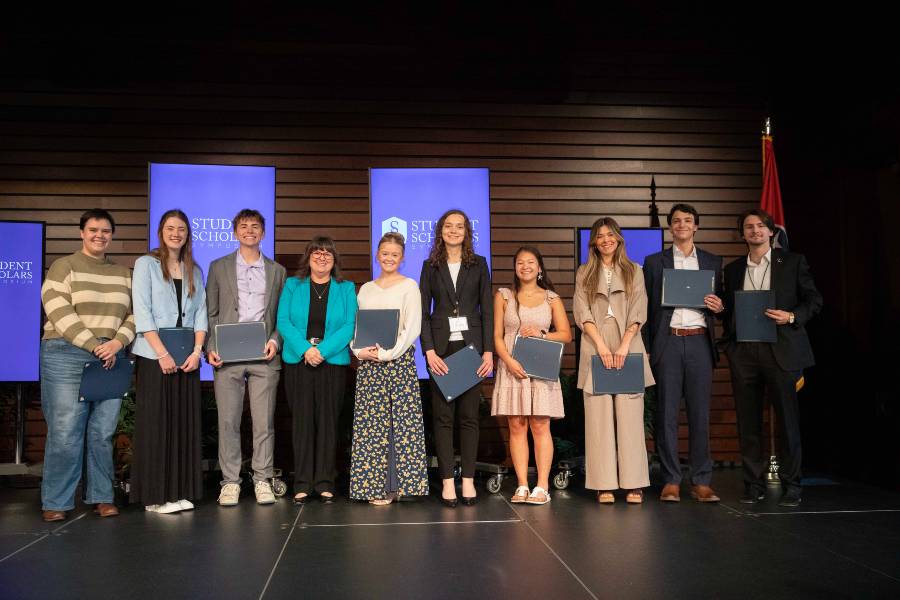
An outstanding presenter from each oral presentation session and from each of 22 poster presentation groups is selected to be honored.
Rethinking Music Theory Pedagogy
Kathryn Williamsen, Music
Investigating the use of indole compounds as potential therapeutics for the treatment of necrotizing enterocolitis
Arlo Colvard, Biology
Congratulations also to the 11 freshmen who presented in the inaugural FOCUS session and the 46 students who presented creative works such as poetry, music and theatrical scenes.
Graduate
“You are the Potter I Am the Clay” … Tracing Egyptian Creation, Cult, and Ritual Power motifs in the Pentateuch.
Christopher Jenkins, Archaeology
In Vitro and In Vivo Preclinical Development of the Cyclopeptide Ent-Verticilide for the Treatment of Cardiac Arrhythmias
Kevin Wu, Pharmaceutical Sciences
Impact of an Educational Intervention on Pharmacy Students’ Knowledge, Attitudes, and Confidence Regarding Alcohol and Substance Use Disorders
Lina Itenberg, Pharmacy Practice
Pharmacokinetic-guided optimization of high dose oral montelukast in children with acute asthma exacerbations
Dana Dishman, Pharmaceutical Science
Examining the Influence of Mapped Bloom’s Taxonomy Items on the Student Pharmacist Experience
Annaston Young, Pharmaceutical Science
